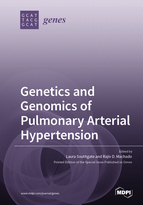Genetics and Genomics of Pulmonary Arterial Hypertension
A special issue of Genes (ISSN 2073-4425). This special issue belongs to the section "Molecular Genetics and Genomics".
Deadline for manuscript submissions: closed (10 September 2020) | Viewed by 37837
Special Issue Editors
Interests: rare disease; medical genetics; human genomics; vascular disease
Interests: pulmonary arterial hypertension; rare and common genetic variation in pulmonary arterial hypertension; next generation sequencing analysis of childhood pulmonary arterial hypertension; genetic factors underlying Adams-Oliver syndrome; analysis of under-studied patient populations in rare disease
Special Issue Information
Dear Colleagues,
Pulmonary arterial hypertension (PAH) is a severe and progressive vascular disorder, which typically manifests at around 30–40 years of age and is often fatal. Pathogenic mutation of the bone morphogenetic protein receptor type 2 (BMPR2) gene is the major PAH risk factor, with over 480 distinct variants reported to date. However, PAH demonstrates substantial locus heterogeneity and missing heritability, particularly in sporadic disease. Whilst BMPR2 mutations account for up to 86% of familial PAH, the vast majority of idiopathic cases remain genetically unresolved. In addition, the genetic aetiology of childhood-onset disease is often more heterogeneous with a poorer prognosis, necessitating dedicated studies to improve molecular diagnosis and clinical management.
With the advent of next-generation sequencing, there has been an explosion of new findings in PAH, expanding the genetic architecture of idiopathic disease and highlighting numerous additional risk factors and novel pathways for exploration. In this Special Issue, we aim to provide an overview of the advancements in PAH genetics and genomics over the past decade, and to examine the emerging interplay between genotype and phenotypic outcomes. We also seek to discuss the role of epigenetics and common variation in the pathogenesis of PAH.
Dr. Laura Southgate
Dr. Rajiv Machado
Guest Editors
Manuscript Submission Information
Manuscripts should be submitted online at www.mdpi.com by registering and logging in to this website. Once you are registered, click here to go to the submission form. Manuscripts can be submitted until the deadline. All submissions that pass pre-check are peer-reviewed. Accepted papers will be published continuously in the journal (as soon as accepted) and will be listed together on the special issue website. Research articles, review articles as well as short communications are invited. For planned papers, a title and short abstract (about 100 words) can be sent to the Editorial Office for announcement on this website.
Submitted manuscripts should not have been published previously, nor be under consideration for publication elsewhere (except conference proceedings papers). All manuscripts are thoroughly refereed through a single-blind peer-review process. A guide for authors and other relevant information for submission of manuscripts is available on the Instructions for Authors page. Genes is an international peer-reviewed open access monthly journal published by MDPI.
Please visit the Instructions for Authors page before submitting a manuscript. The Article Processing Charge (APC) for publication in this open access journal is 2600 CHF (Swiss Francs). Submitted papers should be well formatted and use good English. Authors may use MDPI's English editing service prior to publication or during author revisions.
Keywords
- Pulmonary arterial hypertension
- Genomics of pulmonary hypertension
- Next-generation sequencing
- Cardiovascular genetics
- Epigenetics
- Genotype–phenotype correlation
- Personalised medicine








